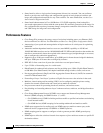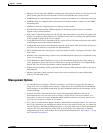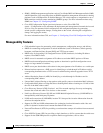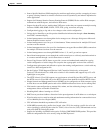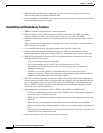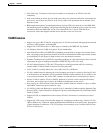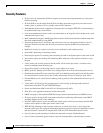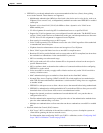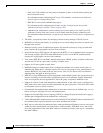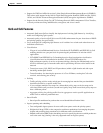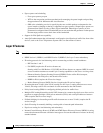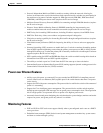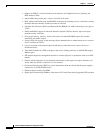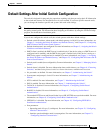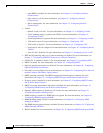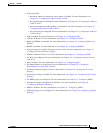
1-12
Catalyst 3750 Switch Software Configuration Guide
OL-8550-09
Chapter 1 Overview
Features
–
NAC Layer 2 IP validation of the posture of endpoint systems or clients before granting the
devices network access.
For information about configuring NAC Layer 2 IP validation, see the Network Admission
Control Software Configuration Guide.
–
IEEE 802.1x inaccessible authentication bypass.
For information about configuring this feature, see the “Configuring the Inaccessible
Authentication Bypass Feature” section on page 10-57.
–
Authentication, authorization, and accounting (AAA) down policy for a NAC Layer 2 IP
validation of a host if the AAA server is not available when the posture validation occurs.
For information about this feature, see the Network Admission Control Software Configuration
Guide.
• TACACS+, a proprietary feature for managing network security through a TACACS server
• RADIUS for verifying the identity of, granting access to, and tracking the actions of remote users
through AAA services
• Kerberos security system to authenticate requests for network resources by using a trusted third
party (requires the cryptographic versions of the software)
• Secure Socket Layer (SSL) Version 3.0 support for the HTTP 1.1 server authentication, encryption,
and message integrity and HTTP client authentication to allow secure HTTP communications
(requires the cryptographic version of the software)
• Voice aware IEEE 802.1x and MAC authentication bypass (MAB) security violation to shut down
only the data VLAN on a port when a security violation occurs
• Support for IP source guard on static hosts.
• RADIUS Change of Authorization (CoA) to change the attributes of a certain session after it is
authenticated. When there is a change in policy for a user or user group in AAA, administrators can
send the RADIUS CoA packets from the AAA server, such as Cisco Secure ACS to reinitialize
authentication, and apply to the new policies.
• IEEE 802.1x User Distribution to allow deployments with multiple VLANs (for a group of users) to
improve scalability of the network by load balancing users across different VLANs. Authorized
users are assigned to the least populated VLAN in the group, assigned by RADIUS server.
• Support for critical VLAN with multiple-host authentication so that when a port is configured for
multi-auth, and an AAA server becomes unreachable, the port is placed in a critical VLAN in order
to still permit access to critical resources.
• Customizable web authentication enhancement to allow the creation of user-defined login, success,
failure and expire web pages for local web authentication.
• Support for Network Edge Access Topology (NEAT) to change the port host mode and to apply a
standard port configuration on the authenticator switch port.
• VLAN-ID based MAC authentication to use the combined VLAN and MAC address information for
user authentication to prevent network access from unauthorized VLANs.
• MAC move to allow hosts (including the hosts connected behind an IP phone) to move across ports
within the same switch without any restrictions to enable mobility. With MAC move, the switch
treats the reappearance of the same MAC address on another port in the same way as a completely
new MAC address.



